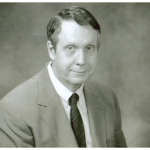Dr. Paulus’ work with Dr. Whitehouse yielded more fruitful collaborations. A book chapter they cowrote on classification of potential treatments for chronic inflammatory diseases such as RA and SLE was “another key paper in my development,” notes Dr. Paulus. In logical, elegantly clear prose, the chapter introduced the concept “that a Prime Cause initiates tissue injury, which is magnified by mediators produced by the host in response to the tissue injury, followed by the nonspecific, normal protective inflammatory response that attempts to heal the injured tissue.”3
On the Trail Toward Treatments
Concomitant with his investigations into and writings about the mechanisms of chronic inflammation, Dr. Paulus was volunteered by Dr. Pearson to serve on an ad hoc committee being set up to advise the FDA on clinical trial guidelines for arthritis treatments. Dr. Paulus was co-author of a working draft for clinical testing guidelines and became a pivotal force in the dawning disease-modifying antirheumatic drug (DMARD) era.4
“Hal Paulus was able to carefully communicate what we knew, what we didn’t know, what we needed to do better, what we needed to define, and then took steps to move things forward in the context of clinical research, trials, and training,” says Michael B. Brenner, MD, Theodore B. Bayles professor of medicine at Harvard Medical School, and chief, Division of Rheumatology, Immunology and Allergy at Brigham and Women’s Hospital in Boston, who began his UCLA rheumatology fellowship in 1978.
Defining the Specialty
Dr. Paulus was able to merge his clinical, teaching, and research skills throughout his tenure at UCLA and led by example. “Hal Paulus was defining the specialty of academic rheumatology before it was formalized [the first ABIM Subspecialty Board in Rheumatology was given in 1972],” continues Dr. Brenner. “He has played a big role in shaping the specialty by defining how to do clinical trials, conducting clinical trials, and training generations of academic and practicing rheumatologists.”
Robert F. Ashman, MD, professor emeritus of medicine and microbiology, University of Iowa Medical School in Iowa City, trained with Dr. Paulus as a rheumatology fellow at UCLA in 1972 and went on as a faculty member until 1980. “Hal was one of my most influential mentors,” he recalls. “I coveted his wonderful patient assessment skills and tried hard to learn them. Their core was common sense. That quality also determined his success in designing clinical studies so that they would actually permit conclusions and allow comparisons to other studies. He had a dry sense of humor and a mischievous grin. That was one of the ways he communicated his unmistakable sense of enjoyment of being a clinical rheumatologist.”

